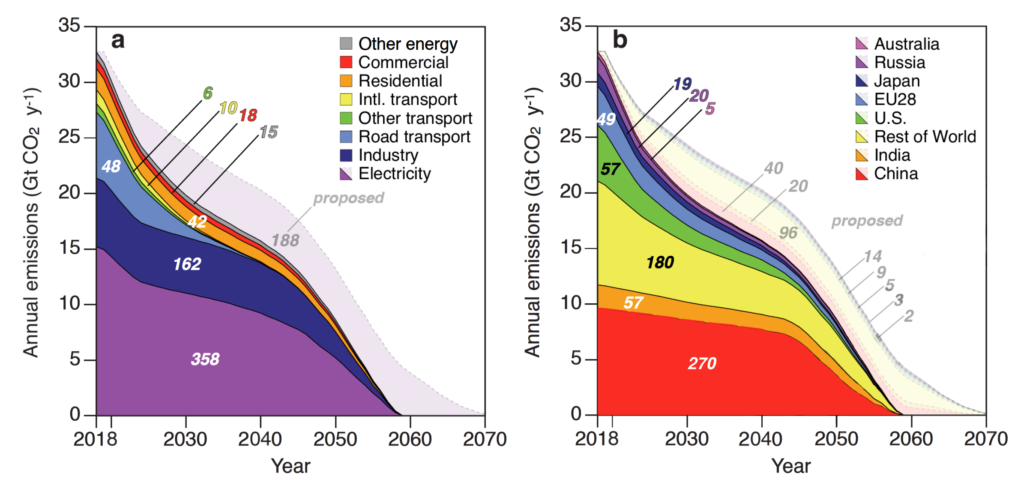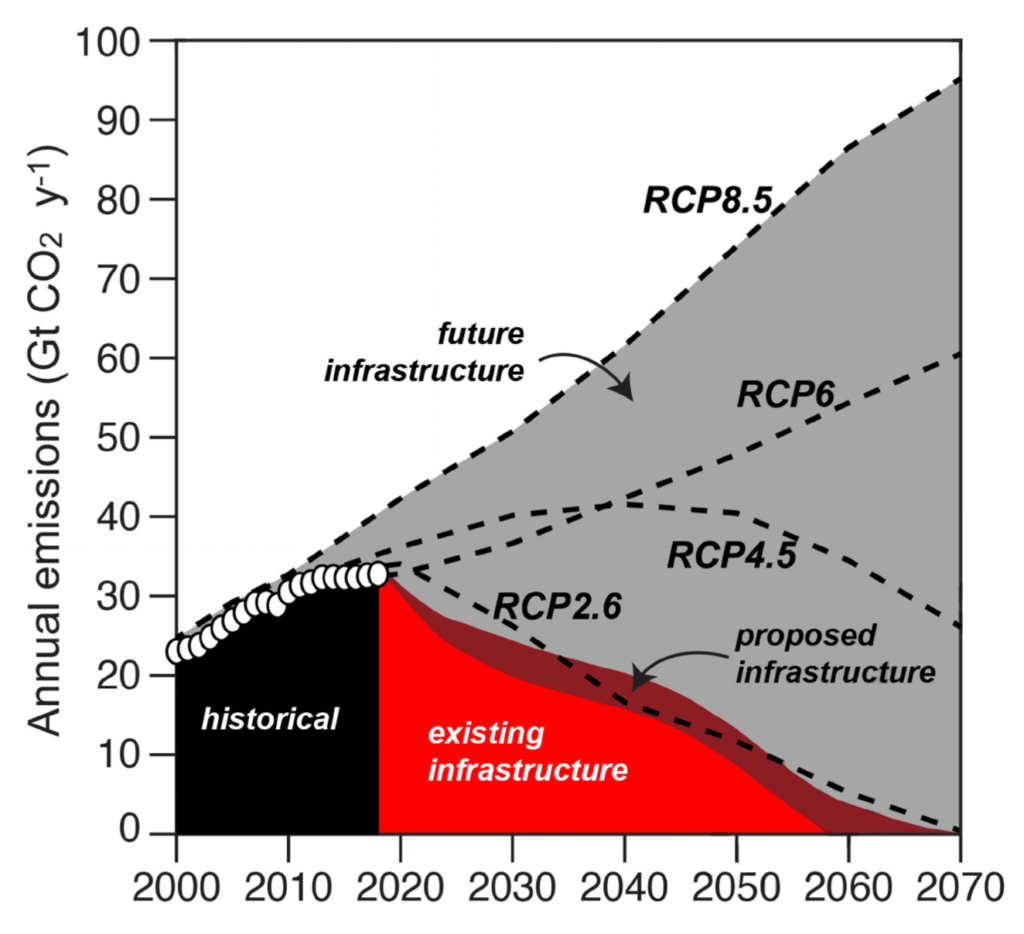“Committed” CO2 emissions jeopardize international climate goals – Existing, planned fossil fuel-burning infrastructure must be retired early, replaced – “Without such radical changes, we fear the aspirations of the Paris agreement are already at risk”

IRVINE, California, 1 July 2019 (UCI News) – The nations that have signed agreements to stabilize the global mean temperature by 2050 will fail to meet their goals unless existing fossil fuel-burning infrastructure around the world is retired early, according to a study [pdf] – published today in Nature – by researchers at the University of California, Irvine and other institutions. [cf. We’ve already built too many power plants and cars to prevent 1.5 ˚C of warming. –Des]
“We need to reach net-zero carbon dioxide emissions by midcentury to achieve stabilization of global temperatures as called for in international agreements such as the Paris accords,” said lead author Dan Tong, a UCI postdoctoral scholar in Earth system science. “But that won’t happen unless we get rid of the long-lasting power plants, boilers, furnaces, and vehicles before the end of their useful life and replace them with non-emitting energy technologies.”
The number of fossil fuel-burning power plants and vehicles in the world has increased dramatically in the past decade, spurred by rapid economic and industrial development in places such as China and India. Meanwhile, the average age of infrastructure in developed countries has decreased. For example, old coal power plants in the U.S. have been supplanted by new natural gas ones which release far less CO2.
According to the study, emissions from existing energy infrastructure take up the entire carbon budget to limit mean warming to 1.5 degrees Celsius and close to two-thirds of the budget to keep warming to under 2°C over the next three decades.
Our results show that there’s basically no room for new CO2-emitting infrastructure under the international climate goals.
Steven Davis, a UCI associate professor of Earth system science
Although the pace of growth of fossil fuel-burning infrastructure has slowed in recent years, a significant amount of new electricity-generating capacity has been proposed globally; some of it is already under construction. If this prospective infrastructure is built, total future emissions take up three-quarters of the budget to constrain warming to below 2°C.
Tong and her colleagues used detailed data sets of existing fossil fuel-burning infrastructure in 2018 to estimate “committed” carbon dioxide emissions. They assumed that power plants and industrial boilers will operate for about 40 years and that light-duty vehicles will be on the road for 15 years, with some regional variation in fuel economy and annual miles traveled.
The researchers also tested different lifetime assumptions in order to see how early CO2-emitting infrastructure might need to be retired in order to meet international climate goals. For example, a 1.5°C boost in mean temperature might still be avoided if current power plants were shuttered after 25, rather than 40 years of operation.

If existing infrastructure operates as usual, though, it will emit about 658 gigatons of CO2 during its operational lifetime, the scientists found. More than half of these emissions are projected to come from the electricity sector, with China producing the largest share, 41 percent, the U.S. producing 9 percent and the European Union 7 percent. If built, power plants being planned, permitted or under construction would emit an additional 188 gigatons of CO2, approximately, according to the study.
“Our results show that there’s basically no room for new CO2-emitting infrastructure under the international climate goals,” said co-author Steven Davis, a UCI associate professor of Earth system science. “Rather, existing fossil fuel-burning power plants and industrial equipment will need to be retired early unless they can be feasibly retrofitted with carbon capture and storage technologies or their emissions are offset by negative emissions. Without such radical changes, we fear the aspirations of the Paris agreement are already at risk.”
Contributors to this work, which received funding from the National Science Foundation, include Ken Caldeira of the Department of Global Ecology at the Carnegie Institution for Science in Stanford; Christine Shearer of San Francisco-based CoalSwarm; Qiang Zhang and Yizuan Zheng of the Department of Earth System Science at Beijing’s Tsinghua University; and Chaopeng Hong and Yue Qin of UCI’s Department of Earth System Science.
Contact
- Brian Bell, 949-824-8249, bpbell@uci.edu
‘Committed’ CO2 emissions jeopardize international climate goals, UCI-led study finds
ABSTRACT: Net anthropogenic carbon dioxide (CO2) emissions must approach zero by mid-century (2050) to stabilize global mean temperature at the levels targeted by international efforts1–5. Yet continued expansion of fossil-fuel energy infrastructure implies already ‘committed’ future CO2 emissions6–13. Here we use detailed datasets of current fossil-fuel-burning energy infrastructure in 2018 to estimate regional and sectoral patterns of ‘committed’ CO2 emissions, the sensitivity of such emissions to assumed operating lifetimes and schedules, and the economic value of associated infrastructure. We estimate that, if operated as historically, existing infrastructure will emit about 658 gigatonnes (Gt) of CO2 (ranging from 226 to 1,479 Gt CO2 depending on assumed lifetimes and utilization rates). More than half of these emissions are projected to come from the electricity sector, and infrastructure in China, the USA and the EU28 countries represent approximately 41 per cent, 9 per cent and 7 per cent of the total, respectively. If built, proposed power plants (planned, permitted or under construction) would emit approximately an additional 188 (range 37–427) Gt CO2. Committed emissions from existing and proposed energy infrastructure (about 846 Gt CO2) thus represent more than the entire remaining carbon budget if mean warming is to be limited to 1.5 °C with a probability of 50–66 per cent (420–580 Gt CO2)5, and perhaps two-thirds of the remaining carbon budget if mean warming is to be limited to below 2 °C (1,170–1,500 Gt CO2)5. The remaining carbon budget estimates are varied and nuanced14,15, depending on the climate target and the availability of large-scale negative emissions16. Nevertheless, our emission estimates suggest that little or no additional CO2-emitting infrastructure can be commissioned, and that infrastructure retirements that are earlier than historical ones (or retrofits with carbon capture and storage technology) may be necessary, in order to meet the Paris Agreement climate goals17. On the basis of the asset value per ton of committed emissions, we estimate that the most cost-effective premature infrastructure retirements will be in the electricity and industry sectors, if non-emitting alternative technologies are available and affordable4,18.
Committed emissions from existing energy infrastructure jeopardize 1.5 °C climate target [pdf]


